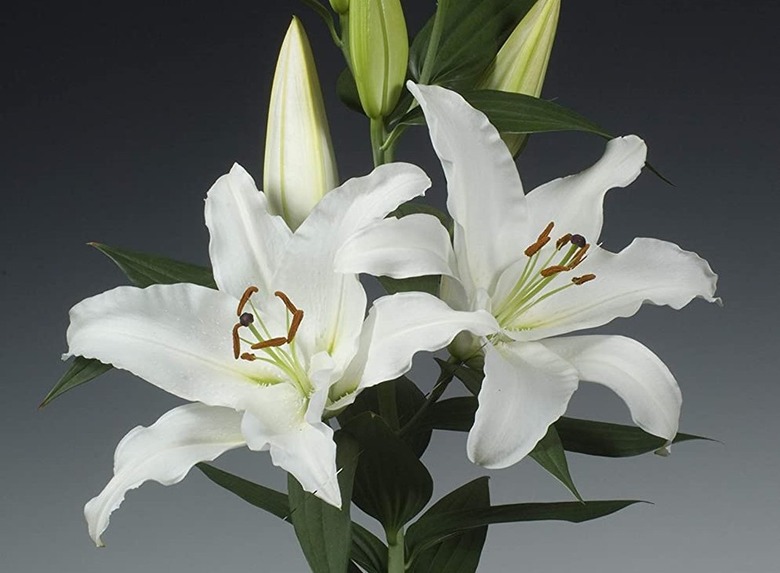How To Care For Oriental Lilies Indoors
We may receive a commission on purchases made from links.
Oriental lilies (Lilium) produce large, beautiful, scented flowers in a variety of colors, including white, pink, red, and purple. They have quite a large range on the USDA plant hardiness zone map, growing in zones 3 through 8, but if you live outside this range, don't have much space outdoors, or want a plant to brighten your indoor areas, growing oriental lilies indoors may be an option.
Things Needed
How to Grow Oriental Lilies Indoors
1. Fill a Pot With Potting Mix
Choose a large, heavy pot that's at least 12 inches deep with bottom drainage holes. Add a 2-inch layer of gravel in the bottom and fill the pot with high-quality potting mix to about 2 inches from the top.
2. Plant the Lily Bulb
Use a small trowel to make a hole in the potting mix. The hole should be a bit wider than your lily bulb and about 2 1/2 times as deep as the bulb's height. Insert the bulb in the hole root side down and pointed tip up and cover it with the surrounding potting mix, pressing down gently. Make sure that the bulbs are moist and not dried out. It's best to plant them soon after buying them.
Tip
You can comfortably plant one 4- to 5-inch bulb in an 8- to 9-inch container and up to four 2- to 3-inch bulbs in a 9- to 10-inch container. Space the bulbs at least 2 inches apart if you're planting more than one per container.
3. Water Thoroughly and Place in an Optimum Location
Once the bulbs are planted, water the potting mix thoroughly, adding a final layer of gravel to help conserve moisture if you like. Place the pot in a sunny area, such as a sunroom if you have one, as these plants require full sun, or six to eight hours of direct sunlight daily, to flourish and flower.
Special Care for Your Indoor Lily
Special Care for Your Indoor Lily
Although indoor oriental lily care may be similar to that of other houseplants in some respects, there are special requirements to keep in mind:
- Keep the potting mix consistently moist but not sopping wet. A good rule of thumb is to water when the top inch or so of the potting mix feels dry to the touch.
- You may also want to add stakes to support the plants as they grow taller. Some oriental lily cultivars, such as Casa Blanca and Stargazer, can grow as tall as 4 to 5 feet. Stakes are important for growing these plants outdoors, but you may find that supportive stakes are a good idea for your indoor lilies too.
- Fertilize your lilies about four weeks after planting and then once a year after that. A slow-release fertilizer is best.
- Remove dead or wilting flowers using clean, sharp scissors or hand pruners, but leave the stems and leaves alone as long as they're still green. Once they've turned yellow or brown, which may not happen until late fall, snip them off at the base of the plant.
- Lilies need a chilling period during winter every year to allow them to enter dormancy before successfully blooming again in subsequent years. You can handle this by leaving your potted lily bulbs in an unheated shed, porch, or garage during winter. Or you can refrigerate them for at least six to eight weeks at a temperature between 40 and 45 degrees Fahrenheit. Don't store your lilies in a refrigerator that also contains fruit, though, as ripening fruit emits ethylene gas, which interferes with flower development.
Warning
If you have cats, you may want to think twice about growing oriental lilies indoors. While they are nontoxic to dogs and horses, they can cause kidney failure in cats.
Tips for Forced Flowering
Tips for Forced Flowering
You may want to "force" lily plants to flower, particularly so you can give the plants as gifts for holidays (such as Mother's Day) that fall outside the plants' natural flowering period. If this is your goal, plant prechilled bulbs and give the growing lilies more light than they could get naturally from the sun during winter. Once the lily plants have broken through the potting mix, place grow lights over them. They require at least 16 hours of light per day to produce high-quality flowers that don't fall off the stem prematurely.
